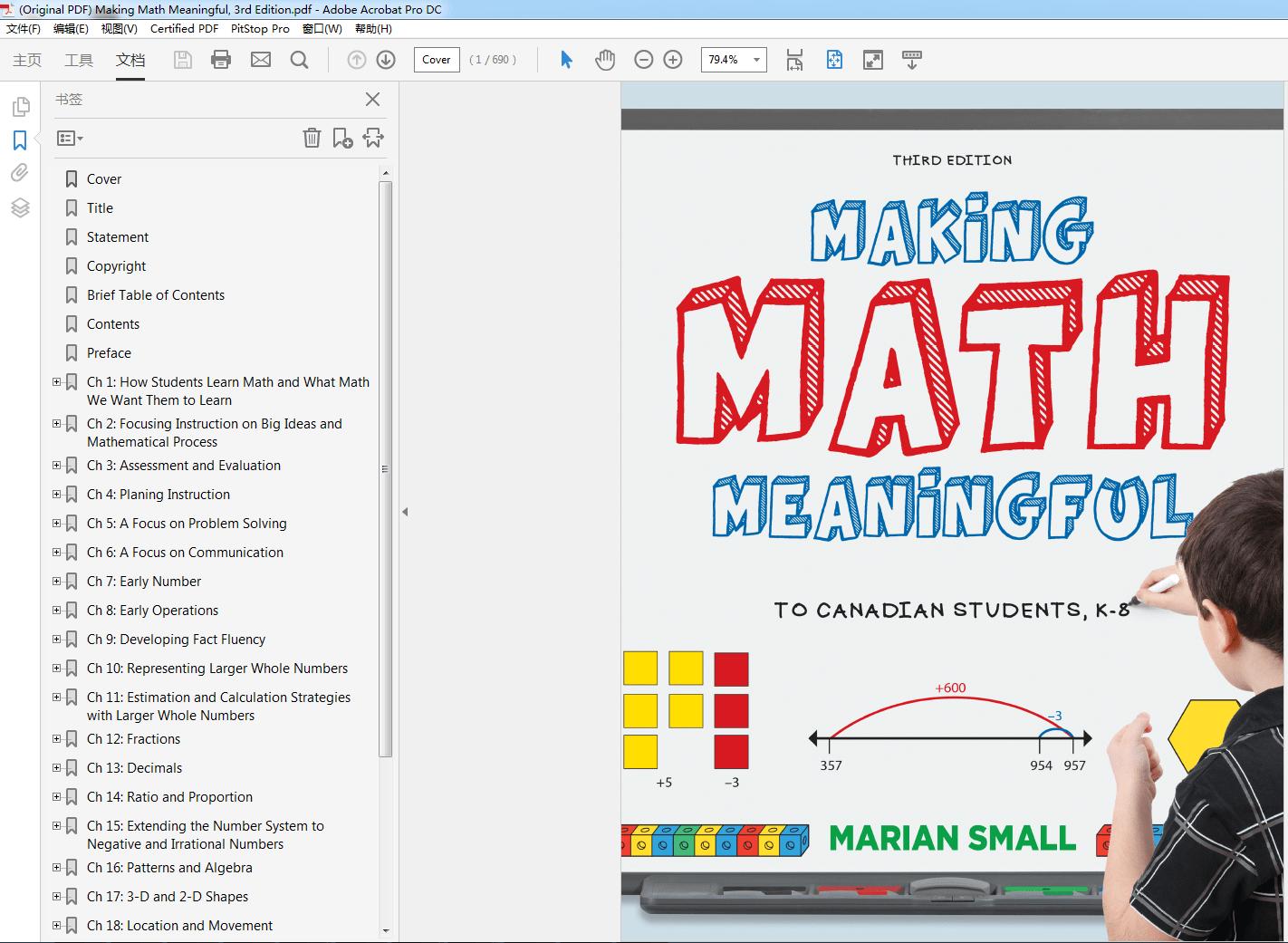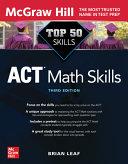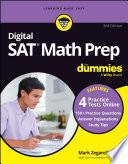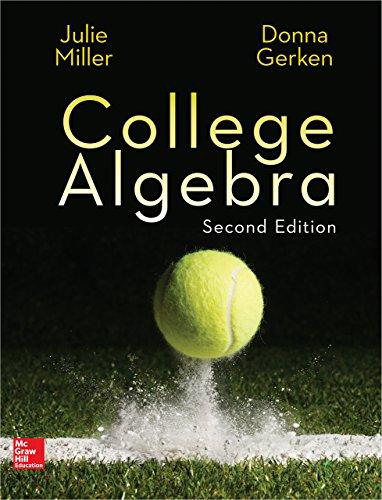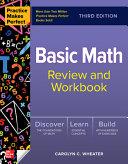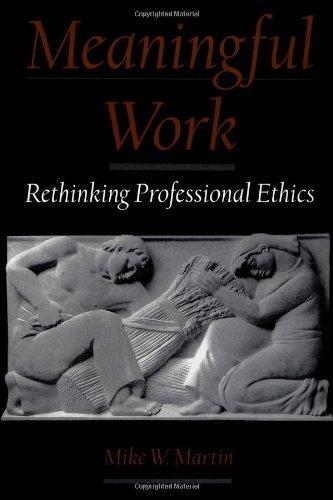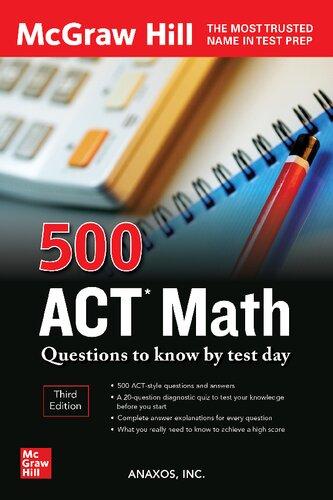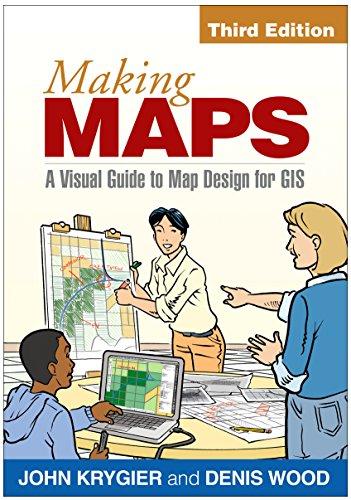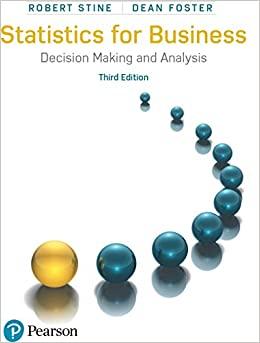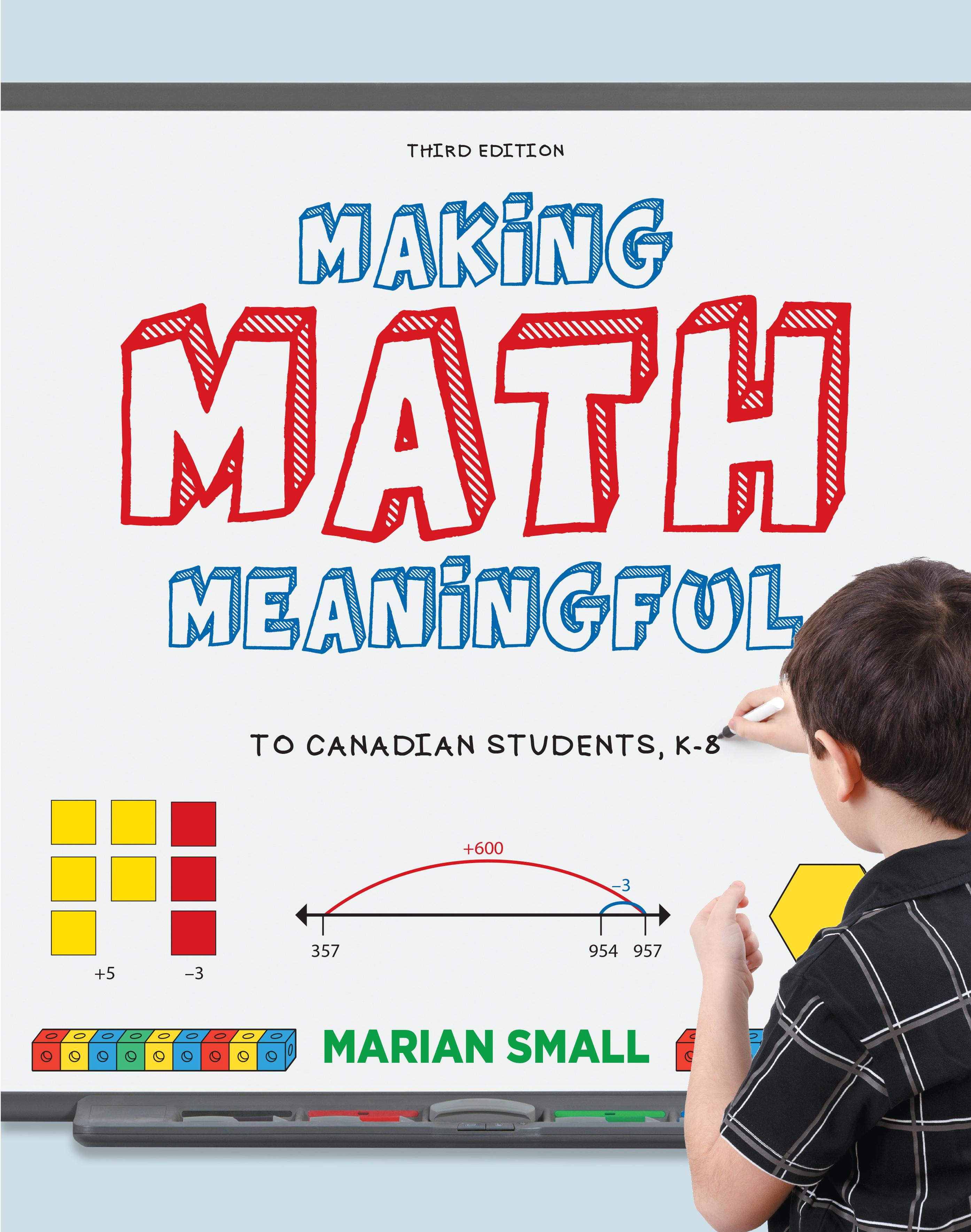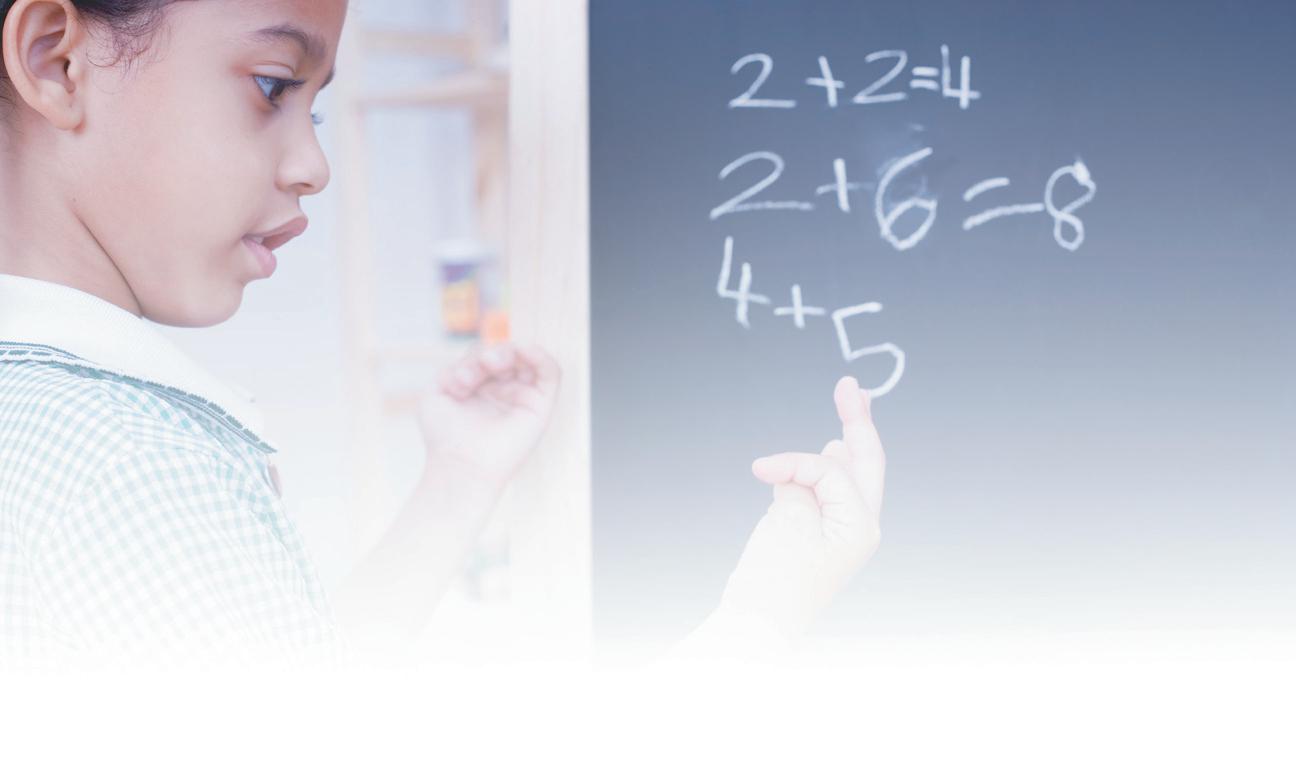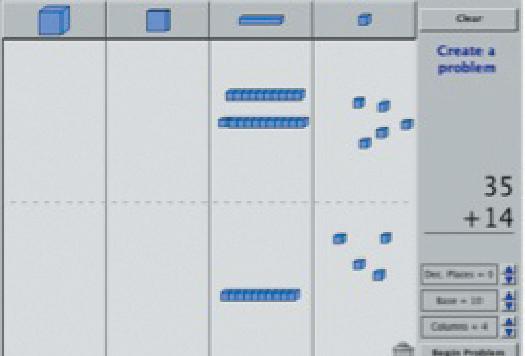(Original
PDF) Making Math Meaningful, 3rd Edition
Visit to download the full and correct content document: https://ebookmass.com/product/original-pdf-making-math-meaningful-3rd-edition/
More products digital (pdf, epub, mobi) instant download maybe you interests ...
Top
50 ACT
Math Skills, 3rd Edition Brian Leaf
https://ebookmass.com/product/top-50-act-math-skills-3rd-editionbrian-leaf/
Digital SAT Math Prep For Dummies 3rd Edition Mark Zegarelli
https://ebookmass.com/product/digital-sat-math-prep-fordummies-3rd-edition-mark-zegarelli/
College Algebra (Collegiate Math) 2nd Edition, (Ebook PDF)
https://ebookmass.com/product/college-algebra-collegiatemath-2nd-edition-ebook-pdf/
Practice Makes Perfect: Basic Math Review and Workbook, 3rd Edition Carolyn Wheater
https://ebookmass.com/product/practice-makes-perfect-basic-mathreview-and-workbook-3rd-edition-carolyn-wheater/
Meaningful
Work: Rethinking Professional Ethics (Practical and Professional Ethics) 1st Edition, (Ebook PDF)
https://ebookmass.com/product/meaningful-work-rethinkingprofessional-ethics-practical-and-professional-ethics-1stedition-ebook-pdf/
500 ACT Math Questions to Know by Test Day, 3rd Edition Inc. Anaxos
https://ebookmass.com/product/500-act-math-questions-to-know-bytest-day-3rd-edition-inc-anaxos/
Making Maps, Third Edition: A Visual Guide to Map Design for GIS 3rd Edition, (Ebook PDF)
https://ebookmass.com/product/making-maps-third-edition-a-visualguide-to-map-design-for-gis-3rd-edition-ebook-pdf/
Statistics for Business: Decision Making and Analysis 3rd Edition
https://ebookmass.com/product/statistics-for-business-decisionmaking-and-analysis-3rd-edition/
MATH AND DOSAGE CALCULATIONS FOR HEALTHCARE PROFESSIONALS 5th Edition, (Ebook PDF)
https://ebookmass.com/product/math-and-dosage-calculations-forhealthcare-professionals-5th-edition-ebook-pdf/
Assessing
Applying What You’ve Learned
Selected
In
Appropriate Manipulatives
Appropriate Children’s Books
Appropriate Digital Resources
Assessing Student Understanding
Applying What You’ve Learned
Selected References
Chapter 9: Developing Fact Fluency
Chapter
In a Nutshell
What
Learning
Larger Numbers in the Student’s World
Common Errors and Misconceptions
Appropriate Manipulatives
Appropriate Children’s Books
Appropriate Digital Resources
Assessing Student Understanding
Applying What You’ve Learned
Selected References
Chapter 11: Estimation and Calculation
Strategies with Larger Whole Numbers
Chapter Problem
In a Nutshell
Addition and Subtraction
Estimating Sums and Differences
Communicating about Adding and Subtracting
Common Errors and Misconceptions
Appropriate Manipulatives
Multiplication and Division
and Dividing Using Powers of 10
Communicating about Multiplying and Dividing
Common Errors and Misconceptions
Appropriate Manipulatives
Appropriate Children’s Books
Appropriate Digital Resources
Assessing Student Understanding
Applying What You’ve Learned
Selected References
Chapter 12: Fractions
Chapter Problem
In a Nutshell
Representing
219
13: Decimals
Percent
Principles for Percent
Common Errors and Misconceptions
Appropriate Manipulatives
Appropriate Children’s Books
Appropriate Digital Resources
Assessing Student Understanding
Applying What You’ve Learned
Selected References
Chapter 15: Extending the Number System to Negative and Irrational Numbers
Chapter Problem
In a Nutshell
Introducing Integers
Integer Contexts
Reading and Writing Integers
Comparing Integers
The Zero Property
Adding Integers
Subtracting Integers
Multiplying Integers
Dividing Integers
Exponents
Using Powers
Appropriate Manipulatives
Appropriate Children’s Books
Appropriate Digital Resources
Assessing Student Understanding
Applying What You’ve Learned
Selected References
Chapter 16: Patterns and Algebra
In
Dissecting and Combining Shapes
Combining Shapes
Dissecting Shapes
Congruence and Similarity
Congruence of 2-D Shapes
Congruence of 3-D Shapes
Similarity of 2-D Shapes
Determining Similarity of 2-D Shapes
Constructing Similar 2-D Shapes
Common Errors and Misconceptions
Appropriate Manipulatives
Appropriate Children’s Books
Appropriate Digital Resources
Assessing Student Understanding
Applying What You’ve Learned
Selected References
Chapter 18: Location and Movement
Chapter Problem
In a Nutshell
Location and
Volume: The Nonstandard Unit Stage 523
Volume: The Standard Unit Stage
Introducing Mass Concepts 530
Mass: The Definition/Comparison Stage
Mass: The Nonstandard Unit Stage 532
Mass: The Standard Unit Stage 534
Common Errors and Misconceptions
Appropriate Manipulatives
Measuring Time and Temperature
Introducing Time Concepts
Time: The Definition/Comparison Stage ����������������������������������
Time: The Nonstandard Unit Stage 543
Time: The Standard Unit Stage 544
Measuring and Calculating Elapsed Time
Introducing Temperature Concepts
Interpreting Negative Temperatures
Estimating Temperatures
Measuring and Calculating Temperature Change
Common Errors and Misconceptions
Appropriate Manipulatives
Measuring Angles
Introducing Angle Concepts
Angles: The Definition/Comparison Stage
Angles: The Nonstandard Unit Stage 558
Angles: The Standard Unit Stage 560
Common Errors and Misconceptions 563
Appropriate Manipulatives
Appropriate Children’s Books
Appropriate Digital Resources
Assessing Student Understanding
Applying What You’ve Learned
Selected References
Chapter 21: Data
Chapter Problem
In a Nutshell
Data Organization
567
Appropriate
Appropriate
Common Errors and Misconceptions
Appropriate Manipulatives
Appropriate Children’s Books
Appropriate Digital Resources
Assessing Student Understanding
Applying What You’ve Learned
Selected References
Index
Credits
This text is designed to provide you with insight into how to make mathematics make sense to students and capture their interest.
Preface
To the prospective or practising K–8 teacher using this book: Many teachers who teach at the K–8 level have not had the luxury of specialist training in mathematics, yet they are expected to teach an increasingly sophisticated curriculum to an increasingly diverse student population in a climate where there are heightened public expectations. They deserve help.
This text is designed to support you in teaching mathematics by providing you with insight into how to make mathematics make sense to students and how to capture their interest. Many practising teachers have told me that there were so many ideas in math that they never understood; they just did what they were told. This text provides you with those missing explanations. As a result, you are more likely to gain the confidence to teach mathematics with a student-centred, problem-solving approach. You will be better able to let students explore because you will have a deeper understanding of the mathematics, which will make it easier for you to deal with students’ varied ideas.
You will be better able to focus discussion in your classroom because you will be more aware of possible misconceptions and of what aspects of the mathematics are worthy of development. You will also be better able to critically evaluate other people’s ideas about how to approach mathematics instruction because you will be starting with a well-founded base of knowledge.
More than that, this text can serve as a resource to which you will return again and again when you are ready to focus on particular content or particular strategies.
Some of the features you will notice include
• chapters dealing with many different aspects of mathematics instruction
– background chapters dealing with the fundamentals of the kind of mathematics students should and can learn, how to focus instruction on the big ideas and the mathematical processes that span grade levels, assessment and evaluation, and planning instruction
– chapters dealing with the mathematical processes of problem solving and communication
– chapters that will make the content clearer and more meaningful to you
• chapter problems to engage you mathematically and that you can later use with students
• the “In a Nutshell” feature to help you focus on the main ideas of each chapter
• highlighted sections that clearly articulate the main principles associated with the content of many chapters
• activities—some of which are open tasks (identified by a blue activity box with an open “top”), and all of which build number sense, algebraic thinking, proportional reasoning, spatial reasoning, critical thinking, or creative thinking—that you can use with students
• teaching tips that reflect the kind of advice an experienced teacher would offer
• student sample responses to show you how students typically respond to certain mathematical tasks
• a focus on Canadian curricula and Canadian approaches to math instruction
• an indication of valuable manipulatives for each content area, with descriptions of how to use them
• charts with common errors and misconceptions described, and strategies to deal with them for each content topic
• some important assessment considerations for each content topic, to supplement the chapter that is dedicated to assessment
• children’s literature suggestions to support the various content topics
• suggestions for appropriate digital resources (an online component)
• opportunities to apply what you have learned in the chapter through self-reflection, talking with your classmates, and interacting with students and teachers in schools
• references to allow you to delve more deeply into topics of interest
To the instructor or facilitator:
There are many texts already available for courses for teacher education in mathematics, so what makes this one different?
I think you will find that this text is particularly accessible while also being thorough. Many prospective and practising teachers who have used the text have commented on how readable it is, with many ideas presented visually as well as with words.
I think you will appreciate the Canadian focus. It was written by a Canadian for a Canadian audience. Decisions made about what curriculum should be addressed are based on the various regional curricula in Canada.
I also think you will appreciate the recognition that most of our teacher education programs in Canada do not allow us the instructional hours to introduce our students to as much as we would like. This resource, along with an instructor’s manual available on the instructor’s website, provides a way to supplement the instruction you offer with the material you would like your students to encounter but do not have time to introduce during class hours. A book study guide is also available on the instructor’s website and is designed to help facilitate professional learning activities for practising teachers. The website has other useful resources such as blackline masters, web links, and a glossary. Go to www.nelson.com/instructor.
What Is New in This Third Edition?
In this third edition, you will find
• increased attention to the issue of mindset
• an enhanced chapter, Chapter 2, on what big ideas in math are and how to teach toward them, including discussion of proportional reasoning, algebraic reasoning, and spatial reasoning, which are spelled out in more detail throughout the resource
• a separate chapter on the acquisition of number facts
• expanded attention to solving proportions, including visual models
• an expanded chapter on integers to encompass order of operations, exponents, and irrational numbers as well
• significant changes in the fraction chapter related to new perspectives on fraction instruction
• very significant changes in the patterns and algebra chapter, with more attention to the link between patterns and algebra and more material on algebra
• streamlining of data chapters
• updates to the reference lists
This resource provides a way to supplement the instruction you offer with the material you would like students to encounter.
Acknowledgments
It has been a privilege to be able to take my many years of working in and thinking about mathematics education and translate it into this text. So many people have played a part—my wonderful university colleagues; the thousands of university students with whom I have worked over the years; the many teachers in whose classrooms I have been invited to work; and my many other professional colleagues across the country and internationally, in school board offices, ministries of education, and other universities.
I have certainly appreciated the many positive comments I have received personally on the usefulness of this text to practising teachers, and I have also appreciated the number of faculty members and school district personnel who have chosen this text as a resource for their students and teachers.
I wish to acknowledge the work of the many editors who have shaped my thoughts into text and graphics that make those ideas so much easier to access. Although many editors have contributed, I must single out the enormous contribution of Jackie Williams, an editor who, over the 25 years we have worked together, constantly challenges and impresses me.
For this third edition, I received excellent advice from
• Ralph Connelly, Brock University
• Limin Jao, University of Toronto
• Laura Jones, York University
• Ann Kajander, Lakehead University
• Tim Pelton, University of Victoria
• David Watson, Western University
I must also thank Nelson Education Ltd., both the Higher Education Division and the School Division, for their faith in me and for their support.
Last, but certainly not least, I would like to thank my friends and family, who always support me.
About the Author
Marian Small is the former Dean of Education at the University of New Brunswick. She has been a professor of mathematics education and worked in the field for close to 40 years. Dr. Small is a regular speaker on K–12 mathematics throughout Canada and around the world.
The focus of Dr. Small’s professional work has been the development of curriculum and text materials for students of mathematics. She has been an author on eight text series at both elementary and secondary levels in Canada, the United States, Australia, and Bhutan, and a senior author on six of those series. She has produced materials for and been distributed by several ministries of education across the country. She has served on the author team for the National Council of Teachers of Mathematics Navigation series, Pre-K–2; for four years as the NCTM representative on the Mathcounts question writing committee; and on the editorial panel of the 2011 yearbook on motivation and disposition.
Dr. Small has led the research resulting in the creation of maps describing student mathematical development in each of the five mathematical strands for the K–8 level, and has created the associated professional development
program, PRIME. She has also written many professional books focusing on differentiated instruction, big ideas in math, and teacher questioning: Big Ideas from Dr. Small, K–3; Big Ideas from Dr. Small, 4–8; and Big Ideas from Dr. Small, 9–12, published by Nelson Education; Good Questions: Great Ways to Differentiate Instruction; More Good Questions: Great Ways to Differentiate Instruction; Uncomplicating Fractions to Meet Common Core Standards in Math, K–7; and Building Proportional Reasoning Across Grades and Math Strands, K–8, co-published by Teachers College Press, the National Council of Teachers of Mathematics, and Nelson Education; Uncomplicating Algebra to Meet Common Core Standards in Math, K–8, co-published by Teachers College Press and Nelson Education; and Open Questions for the Three-Part Lesson, K–3 and 4–8, published by Rubicon Publishing. Recently she has also produced intervention materials for Grade 3–8 students, Leaps and Bounds toward Math Understanding, also published by Nelson Education.
Instructor Resources
The Nelson Education Teaching Advantage (NETA) program delivers research-based instructor resources that promote student engagement and higher-order thinking to enable the success of Canadian students and educators. Visit Nelson Education’s Inspired Instruction website at http:// www.nelson.com/inspired/ to find out more about NETA.
The following instructor resources have been created for Making Math Meaningful to Canadian Students. Access these ultimate tools for customizing lectures and presentations at www.nelson.com/instructor.
Image Library
This resource consists of digital copies of figures and art, charts, and student work used in the book. Instructors may use these jpegs to create their own PowerPoint presentations.
Instructor Guide
This resource was written by Marian Small. It is organized according to the textbook chapters and addresses key educational concerns, such as typical stumbling blocks students face and how to address them. Other features include teaching suggestions, assessment tools, and possible projects or demonstrations.
Book Study Guide for Professional Learning
In a number of school districts, this text is purchased for teacher reference. The Book Study Guide has been written by Marian Small to be used as a resource for teaching professionals who are taking part in a “book study” of Making Math Meaningful, usually set up informally by several teachers within a school, or school-wide, or teachers within a family of schools, or board-wide on a voluntary basis.
Blackline Masters
Blackline masters have been created by Marian Small. The author has provided a set of 35 generic reproducible blackline masters including 10-frames, 100-charts, place value charts, clock faces, tangrams, and many others.
MindTap
Offering personalized paths of dynamic assignments and applications, MindTap is a digital learning solution that turns cookie-cutter into cutting-edge, apathy into engagement, and memorizers into higher-level thinkers. MindTap enables students to analyze and apply chapter concepts within relevant assignments, and allows instructors to measure skills and promote better outcomes with ease. A fully online learning solution, MindTap combines all student learning tools—readings, multimedia, activities, and assessments—into a single Learning Path that guides the student through the curriculum. Instructors personalize the experience by customizing the presentation of these learning tools to their students, even seamlessly introducing their own content into the Learning Path.
Student Ancillaries
MindTap
Stay organized and efficient with MindTap—a single destination with all the course material and study aids you need to succeed. Built-in apps leverage social media and the latest learning technology. For example,
• ReadSpeaker will read the text to you.
• Flashcards are pre-populated to provide you with a jump start for review—or you can create your own.
• You can highlight text and make notes in your MindTap Reader. Your notes will flow into Evernote, the electronic notebook app that you can access anywhere when it’s time to study for the exam.
• Self-quizzing allows you to assess your understanding.
Visit http://www.nelson.com/student to start using MindTap. Enter the Online Access Code from the card included with your text. If a code card is not provided, you can purchase instant access at NELSONbrain.com.
Research on Mathematical Learning
One of the valuable tools that teachers of mathematics have in the twentyfirst century is an increasingly more solid base of research on student learning and mathematics teaching that they can draw upon to inform their instructional strategies. Although research in psychology informed mathematics education in the past—particularly research around optimal ways to teach procedures—research is now much more broadly based, dealing with the acquisition of conceptual understanding as well as skills. Two particularly valuable and accessible research compendiums are A Research Companion to Principles and Standards for School Mathematics (Kilpatrick, Martin, and Schifter, 2003), and Adding It Up: Helping Children Learn Mathematics (National Research Council, 2001), which address some of the research cited below, in addition to many other studies.
The Importance of Conceptual Understanding
We all have our own mental pictures of what mathematical understanding looks like.
Carpenter and Lehrer (1999) help us to clarify what we might mean. They speak to the development of understanding not only as the linking of new ideas to existing ones, but as the development of richer and more integrative knowledge structures. These structures allow students to use the new ideas they learn, rather than to only be able to repeat what they have learned.
For example, a student who fully understands what 3 3 5 means not only realizes that it equals 15, but, at some point, understands all of the following as well:
• It represents the amount in 3 equal groups of 5, no matter what is in the groups.
• It represents the sum of 5 1 5 1 5.
• It represents the area of a rectangle with dimensions 3 and 5.
• It represents the number of combinations of any 3 of one type of item matched with any 5 of another type of item (e.g., 3 shirts and 5 pairs of pants 5 15 outfits).
• It represents the result when a rate of 5 is applied 3 times (e.g., going 5 km/h for 3 hours).
• It describes the final length if a length of 5 units is stretched to triple its size.
Because the student realizes what 3 3 5 means, he or she can use it to figure out 6 3 5, 4 3 5, 3 3 6, etc., as well as multiply multi-digit numbers like 3 3 555 and solve a variety of problems involving multiplication of 3 by 5.
Carpenter and Lehrer suggest that understanding is achieved as students engage in these processes:
• constructing relationships
• extending and applying mathematical knowledge
• reflecting about their mathematical experiences
• articulating what they know mathematically
• personalizing mathematical knowledge
They speak to the fact that understanding is most likely to develop in classrooms that focus on problems to be solved, rather than exercises to be completed; classrooms where alternative strategies are discussed and valued; and classrooms where student autonomy is valued.
There have been a number of studies that have examined how students learn mathematics with a deeper understanding. Most of these studies focus on the instructional methods teachers use to facilitate understanding. For example, Ross, Hogaboam-Gray, and McDougall, (2002) report on a variety of studies that show the success of methods based on math reform, that is, classrooms with rich tasks embedded in the real-life experiences of children, and with rich discourse about mathematical ideas. Success was measured on both traditional math tasks and problem-solving tasks.
A Constructivist Approach
The classrooms advocated by Carpenter and Lehrer inevitably value a constructivist approach. Unlike a more traditional approach in which teachers focus on the transmission of mathematical content without
considering how their students are perceiving and mentally integrating what is being said, in a constructivist classroom students are recognized as the ones who are actively creating their own knowledge.
For example, in a constructivist classroom, rather than showing students how to add 47 1 38 by grouping the ones, trading, and then grouping the tens, the teacher might provide students with a variety of counting materials and pose a problem such as, “One bus has 47 students in it; another has 38. How many students are on both buses?” and allow students to use their own strategies to solve the problem. There would normally be a discussion where various approaches are shared and additional ideas become available to students to augment their own.
Cobb (1988) explains that the two goals of a constructivist approach to mathematics are students’ opportunity to develop richer and deeper cognitive structures related to mathematical ideas, and students’ development of a level of mathematical autonomy. In a constructivist classroom, it is through interactions with other students as well as with the teacher, and with the opportunity to articulate their own thoughts, that students are able to construct new mathematical knowledge. These classrooms are ones where varied approaches are expected, shared, and valued. The teacher’s role is less about standing at the front talking and more about circulating, engaging in small conversations, facilitating, and gathering information to inform future instruction.
Using Manipulatives
Since the mid-1960s, there has been a belief that the use of manipulative materials—concrete representations of mathematical ideas—is powerful in developing mathematical understanding. Throughout this text, you will see many examples of how manipulatives can be used to make math make sense. For example, the model in the margin embodies place value concepts by showing how the three different digits of 2 in the number 222 represent three different amounts (2 hundreds, 2 tens, and 2 ones).
It is believed that manipulatives help students by providing
• models the student can refer to (i.e., visualize) even when the manipulatives are no longer present
• a reason for students to work cooperatively to solve problems
• a reason for students to discuss mathematical ideas and verbalize their thinking
• a level of autonomy since students could work with the materials without teacher guidance
Research was conducted in the 1960s, 1970s, and 1980s on the value of using manipulatives. Examples are articles by Suydam (1984) and Ball (1988). There is less current research on manipulatives. However, there are a few more recent studies, for example, Puchner, Taylor, O’Donnell, and Fick (2008), and some newer discussions on the use of virtual (computer) manipulatives (Steen, Brooks, and Lyon, 2006). Virtual manipulatives are valued for a number of reasons, but particularly because they are freely available to all students, even at home.
New tools include technological ones. It could be calculators, but it could be tablets with apps that allow students to record their thinking, or
Modelling 222
digital cameras that allow students to capture their work with concrete materials, or Internet sites that provide access to current data. Clearly, a rich classroom has a mixture of all of these support materials.
This is an example of the use of virtual manipulatives.
Mindset
There is increasing research about how “a growth mindset” plays a big factor in student success in mathematics (Boaler, 2013). When students embrace challenge rather than shy away from it for fear of failing, when they realize that mistakes are okay and that they improve by having gone through the experience, and when they believe that their ability can grow, they perform better.
A growth mindset can be facilitated by avoiding ability groupings, which seem to suggest that ability is stagnant, as well as by sending the right messages in conversations with students. For example, instead of telling a student that we think a task might be too hard for him or her, we show belief in the student. Instead of classifying students as strong or weak, even if only in our own minds, we start to believe that a student can always improve.
What Mathematics We Want Students to Learn
We have talked about how we teach mathematics, but there is also a question about what mathematics we want students to learn.
The mathematics that teachers teach is based primarily on the outcomes/ expectations that their province has decided warrant focus at a particular grade level. Sometimes, teachers supplement this material with other material that they value. But what determines what is valued, either by the provincial or territorial government or by the individual teacher? And what determines the teacher’s approach to teaching the mandated curriculum? Often, it is a perspective on what mathematics really is (Mewborn and Cross, 2007).
National Library of Virtual Manipulatives
Differing Perspectives on What Mathematics Is
Some people might wonder how there could be a debate about what mathematics is. But there really are different perspectives.
Mathematics as a Set of Procedures or Not
For many, and certainly for most people in earlier generations, mathematics is viewed as a set of procedures to memorize, whether arithmetic procedures like adding, subtracting, multiplying, and dividing, or high school procedures like factoring or solving trigonometric equations.
For many of these people, there is only one “optimal” procedure for each of these purposes. For example, there is an appropriate way to do “long division,” an appropriate way to add a negative integer to a positive one, and an appropriate way to factor quadratics.
Others have a broader view of mathematics. They believe that the learning of mathematics should focus as much, or more, on mathematical concepts and ideas as on the skills. For them, it is not just how to add numbers, but it is also what addition is all about, including when it is used, alternative approaches to addition, and how addition connects to other mathematical ideas.
Mathematics as a Hierarchy of Concepts and Skills
Many view mathematics as a very hierarchical subject. They believe there is a well-defined sequence for learning various concepts and skills. For example, most would suggest that you cannot learn about area until you have learned about length. But even though there are numerous points on which many educators agree, and increased sharing of common learning trajectories, there is no single definitive sequence for the teaching of mathematical concepts and skills.
The lack of agreement becomes apparent simply upon examining how different provinces teach the same topic at different grade levels. Neither do researchers always agree. For example, although some argue that you cannot teach division before multiplication, others say that a child could solve the problem, How many cookies do each of the 2 children get if they are sharing 8 cookies?, at the same time as he or she could solve, How many cookies are on 2 plates if there are 4 cookies on each plate? Notice that the first is essentially a division problem, and the second is a multiplication problem.
Mathematics as a Study of Pattern
Some suggest that what distinguishes mathematics from other subjects is the central role that pattern plays in its development. Keith Devlin (1996) argues that numbers are based on recognizing patterns in the world; there is no such object as the number 2, but we see a pattern of twoness to help us understand what 2 represents. If we see enough things that look like what is shown in the margin, we get the idea of what 2 is supposed to mean.
One strand of mathematics is often called patterns and algebra or patterns and relations. In this strand, students explicitly study repeating, growing, shrinking, and recursive patterns (see Chapter 16). But patterns underlie number, geometry, and measurement as well. For example, not only do we use pattern to define number, as described above, but we use it to understand number. Patterns help us learn to multiply by powers of 10, for example, why 3 3 10 5 30, 3 3 100 5 300, and 3 3 1000 5 3000; they
also help us to understand how our counting system works, for example, counting in a pattern where we say twenty, twenty-one, twenty-two, etc., to twenty-nine, going to thirty, and then starting all over again with thirty-one, thirty-two, etc.
Patterns in the place value system help us recognize why the first digit to the right of the decimal point must be tenths and the second digit must be hundredths. Patterns even allow us to make sense of a number we have never seen before (e.g., to know that 478 must be between 400 and 500).
Patterns help us understand our measurement system, for example, why a distance of 2 m can be written as 2000 mm, much as a capacity of 2 L can be written as 2000 mL. They also help us interpret geometric situations, for example, the tessellation (or tiling) shown in the margin as a design of hexagons positioned based on geometric transformations.
Mathematics as a Way of Thinking
Still others look at mathematics in terms of the processes we use to interpret a situation. Devlin (2000) spoke about mathematics as a way of looking at the world. People who think mathematically look at a phenomenon and see the mathematics in it. For example, on a road trip, people who think mathematically often think about what fraction of the trip they have completed at a certain point, and what their speed would have to be to arrive in a certain amount of time. They may even notice the numerical patterns in licence plates of cars that they pass.
As you learn about the various Canadian provincial and regional curriculum documents, you will see that all of them focus on mathematical processes that should be cultivated to provide the opportunity for students to develop their abilities to think mathematically.
Consider the varying views of mathematics described above. Depending on the perspective taken by the teacher or curriculum writer on what mathematics fundamentally is, different topics might be emphasized or taught in a different way.
Differing Perspectives on What Mathematics Is Valued and at What Grade Levels
Provincial Mathematics Curricula
In Canada, each province or territory has jurisdiction over its curriculum. Each has its own program of studies. However, there are regional agreements wherein provinces and/or territories have agreed to share curriculum frameworks for particular topics, including mathematics.
In the last few years, there have been three major curriculum frameworks in mathematics in Canada. These are the Western and Northern Canadian Protocol (WNCP), applying to the four Western provinces, the four Atlantic provinces, and the three territories; the Ontario curriculum; and the Québec curriculum. The WNCP document was then particularized by the various jurisdictions that use it.
The various curriculum documents differ in the level of detail, the specific topics in each grade level, and the processes that are emphasized. For example, if you examined the 2011 curriculum documents with
and tiling
Transformations
regards to teaching number in Grade 1, you would notice many commonalities, but also some noticeable differences, for example, whether it is expected that facts be memorized, whether students encounter fractions, whether there is use of ordinal numbers, and whether the emphasis is on numbers 20, 50, or 100.
Currently, both Alberta and British Columbia are revising their curricula to reorganize them around broader competencies. British Columbia is including big ideas around the content strands and focusing learning around the core competencies of communication, thinking, and personal and social. Alberta is looking at the notion of numeracy benchmarks for various ages. It also is considering essence statements. Both provinces are including notions of cross-curricular competencies, which will address numeracy in other subject areas.
It is unlikely that children in the various parts of the country are that different from one another developmentally, so the curriculum differences are clearly an expression of beliefs and/or values.
Moving from one part of the country to another, you may need to alter the content you teach or perhaps even the language you use to emphasize processes, but you will be teaching content that is focused on students gaining and applying a deep understanding of mathematical ideas and processes wherever you teach in Canada.
National Council of Teachers of Mathematics Principles and Standards
The NCTM is a long-standing organization with a very large membership. Math teachers, consultants, and researchers in both the United States and Canada belong to and contribute to the organization.
NCTM produced the Principles and Standards for School Mathematics (2000) document to articulate a vision for mathematics. The organization indicated which content and which processes should receive focus, and listed a set of six key principles:
Equity. Excellence in mathematics education requires equity—high expectations and strong support for all students.
Curriculum. A curriculum is more than a collection of activities: it must be coherent, focused on important mathematics, and well articulated across the grades.
Teaching. Effective mathematics teaching requires understanding what students know and need to learn, and then challenging and supporting them to learn it well.
Learning. Students must learn mathematics with understanding, actively building new knowledge from experience and prior knowledge.
Assessment. Assessment should support the learning of important mathematics and furnish useful information to both teachers and students.
Technology. Technology is essential in teaching and learning mathematics; it influences the mathematics that is taught and enhances students’ learning.
Important content is identified in each of five mathematical strands (number and operation, algebra, geometry, measurement, and data analysis and probability), and five processes are singled out for consideration:
problem solving, reasoning and proof, communication, connections, and representation. At different grade bands, different strands receive more emphasis, but the processes are critical throughout the grades.
More recently, NCTM (2014) released a document called Principles to Actions: Ensuring Mathematical Success for All. This document clarifies the kinds of actions that need to be taken by individual teachers and systems to ensure that the NCTM vision of accessible, engaging math for all is achieved.
The organization produces journals for teachers and researchers in mathematics at all levels, including Teaching Children Mathematics, Mathematics Teaching in the Middle School, The Mathematics Teacher, and the Journal for Research in Mathematics Education, as well as other electronic resources. These are among the most cited references in mathematics education work.
Public Involvement and Expectations for a Mathematics Curriculum
Increasingly, the public is expressing its opinion about how mathematics should be taught. Many educators find this unsettling; they point out, for example, that the public does not express its opinion in the same way about how medicine or the law should be practised. Yet, because almost every citizen has gone to school, it appears that citizens believe their opinions about educational practice are informed; the notion that there is a body of educational research that is part of the specialized knowledge of educators is not universally accepted.
Similar to the many citizens who expressed concern about a change in philosophy from teaching reading phonetically to what was called a whole language approach (learning to read by reading), many citizens have questioned the advisability of teaching mathematics in a way that does not emphasize standard and uniform approaches to calculations. There has also been concern about less emphasis on memorizing the facts.
It is important for teachers to know how non-teachers feel about these topics, and it is equally important to answer questions that are raised. For example, although it is true that fact memorization is now seen as something that should follow an understanding of what the facts mean, most curricula still speak explicitly to the recall of facts. In other words, we still expect students to recall their facts. Some Ministers of Education have requested revisions in language in provincial curricula to clarify this issue.
The belief that there is only one way to perform an algorithm is mistaken. Although some members of the community may feel that there is a best way to divide, for example, and are not happy that a variety of algorithms are taught to students, in another country a completely different algorithm may be the norm. Neither is better—they are different. In fact, the more tools and approaches that we have, the more likely we are to be successful at a task. And in Canada’s increasingly multicultural classrooms, it is important to honour the different approaches used in different countries.
Some believe that there is simply not enough time for students to “discover” math themselves. However, since we know that many adults who grew up with a more traditional mathematics curriculum continue to
